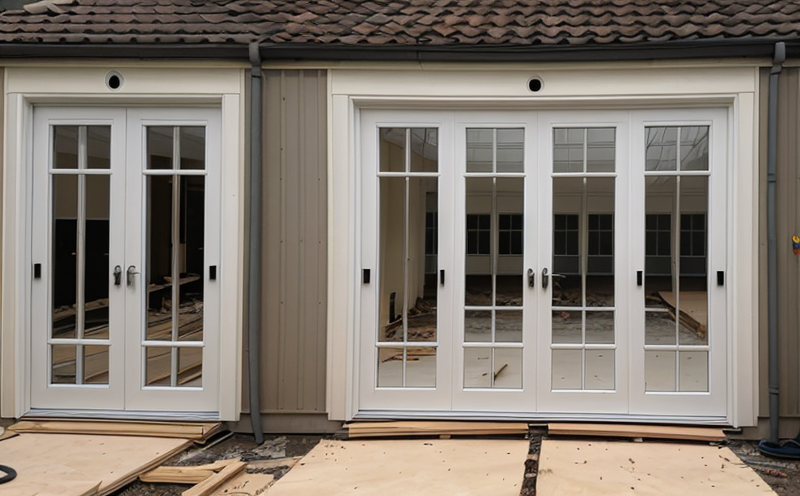Fire Resistance of Metal Clad Doors
The fire resistance testing of metal clad doors is a critical aspect of ensuring compliance with building codes and standards aimed at safeguarding life and property in the event of a fire. Fire resistance tests are conducted to evaluate the ability of metal clad doors, partitions, and other structural elements to withstand exposure to high temperatures and flames without collapsing or compromising their integrity.
These tests are essential for ensuring that metal clad doors meet stringent safety standards such as ISO 15610, EN 1363-3, and ASTM E1966. During these assessments, the door specimens are exposed to controlled fire conditions in a furnace or other testing apparatus designed to simulate real-world fire scenarios.
The primary goal of metal clad door fire resistance tests is to determine whether the door can maintain its structural integrity, prevent the spread of fire and smoke, and provide an effective barrier against heat and flame. The test involves measuring parameters such as time-to-collapse, temperature rise on the non-fire side, and the ability to retain airtightness.
Testing metal clad doors for fire resistance is not just about compliance; it's also about protecting lives and property. In buildings like hospitals, schools, and high-rise structures, where occupants are at higher risk during fires, these tests ensure that critical escape routes remain functional and safe under extreme conditions. Additionally, the fire resistance of metal clad doors can significantly influence the overall fire safety rating of a building.
Compliance with relevant codes and standards is paramount for architects, builders, and manufacturers who must demonstrate their products meet stringent requirements. For instance, in Europe, compliance with EN 1363-3 ensures that the metal clad doors are suitable for use as fire separation elements in construction projects.
The testing process involves rigorous preparation of specimens to replicate real-world conditions accurately. Specimens are typically mounted between two chambers separated by a specific gap width and subjected to controlled heating until they fail or meet specified criteria. The test results provide critical data that helps manufacturers improve product design, enhance performance, and ensure long-term reliability.
Understanding the fire resistance of metal clad doors is crucial for various stakeholders involved in construction projects. Quality managers can use these insights to select materials and components that align with safety standards. Compliance officers rely on test results to verify adherence to regulatory requirements. R&D engineers leverage this information to innovate and develop safer, more effective products. Procurement teams benefit from this knowledge when specifying material suppliers and ensuring they meet necessary quality benchmarks.
For customers, the outcome of these tests ensures peace of mind knowing that the metal clad doors in their buildings are reliable and capable of performing as intended during emergencies. The industry’s reliance on accurate, consistent testing underscores the importance of this service in maintaining public safety standards globally.
Why It Matters
The fire resistance of metal clad doors is crucial for several reasons, primarily related to enhancing building safety and compliance with regulatory requirements. Metal clad doors play a vital role in creating fire barriers within buildings by preventing the spread of fire and smoke. This feature is particularly important in high-risk areas such as hospitals, schools, office buildings, and residential complexes.
Compliance with relevant international standards like ISO 15610, EN 1363-3, ASTM E1966, and others ensures that metal clad doors meet specific performance criteria. These standards outline the methods for testing fire resistance, including exposure to heat, flame, and smoke; measurement of time-to-collapse; and assessment of temperature rise on the non-fire side.
The significance of meeting these standards extends beyond mere compliance. It reflects a commitment to public safety and risk mitigation in construction projects. By incorporating metal clad doors that pass rigorous fire resistance tests, architects, builders, and manufacturers contribute to creating safer environments for occupants during emergencies.
For customers, the reliability of metal clad doors is paramount. Knowing that these doors can withstand fire exposure provides assurance that critical escape routes remain functional and safe in case of a fire. This confidence is essential, especially in high-risk buildings where lives are at stake.
The broader impact of robust fire resistance testing extends to the industry as a whole. By adhering to stringent standards and conducting thorough tests, manufacturers can differentiate their products in an increasingly competitive market. Compliance with these standards also enhances brand reputation and fosters customer trust.
Industry Applications
- Hospitals: Ensuring safe evacuation routes for patients and staff during emergencies.
- Schools: Providing secure exits in case of fire or other safety incidents.
- Office Buildings: Maintaining structural integrity and preventing the spread of fire within multi-story structures.
- Residential Complexes: Protecting homeowners and residents from potential fire hazards.
- Data Centers: Safeguarding critical infrastructure and equipment from fire damage.
Customer Impact and Satisfaction
Customers, including architects, builders, and end-users, benefit significantly from the rigorous testing of metal clad doors. Compliance with international standards ensures that these products meet stringent safety requirements, thereby enhancing public trust and satisfaction.
Architects and builders can select reliable materials knowing they adhere to strict quality control processes. This selection process not only meets regulatory demands but also contributes to creating safer buildings. Builders and developers can rely on the performance data from fire resistance tests to make informed decisions, ensuring that critical safety features are in place.
For end-users, such as building occupants, peace of mind is paramount. Knowing that metal clad doors have passed rigorous testing instills confidence in their structural integrity during emergencies. This assurance can lead to higher satisfaction levels and a better overall experience within the built environment.
The reliability of fire resistance-tested products also impacts customer satisfaction by fostering trust in the construction industry’s commitment to safety and quality. Positive feedback from satisfied customers can further enhance reputation, leading to repeat business and positive word-of-mouth recommendations.





